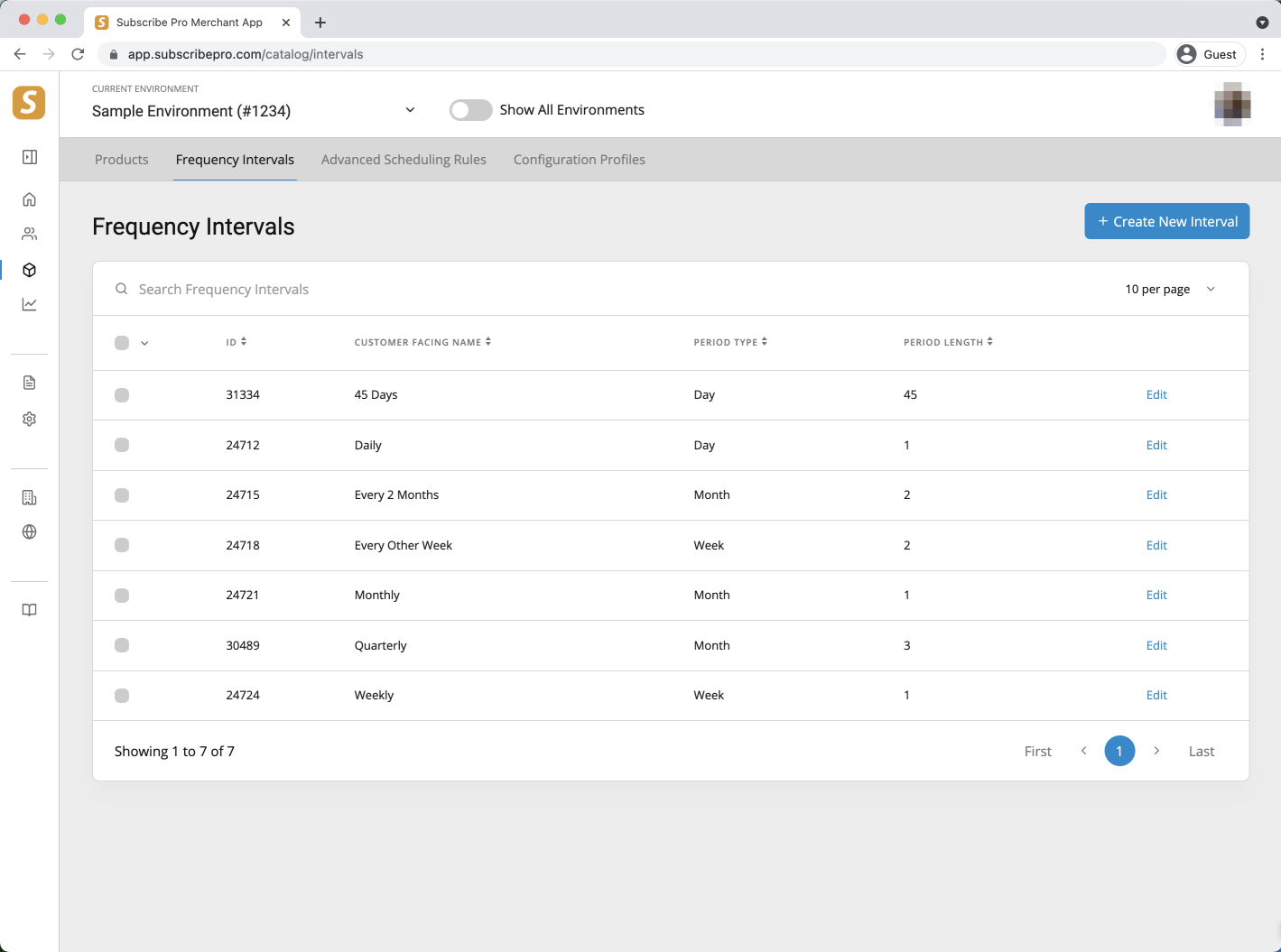Basic Scheduling
The Subscribe Pro Merchant App includes a Frequency Intervals page within the Catalog section which allows you to define the frequencies available for your customers to choose for their subscriptions. You can set up intervals by number of days, weeks, months, quarters, or years.

Interval Behavior
Date calculations based on frequency intervals are typically straightforward, but there are a few edge cases to be aware of. Our system supports the following interval types: Day, Week, Month, Quarter, and Year. The number of units that must pass between each subscription order with the length value. When a subscription is processed and an order goes through successfully, the Next Order Date is automatically incremented based on the interval length and unit.
Here is a table with some examples of how dates will be calculated using some common intervals:
| Interval | Unit | Length | Initial Order Date | First Reorder Date | Second Reorder Date | Third Reorder Date | Fourth Reorder Date |
|---|---|---|---|---|---|---|---|
| Every 30 Days | Day | 30 | 01-Jan | 31-Jan | Leap Year: March 2 | 01-Apr | Apr-31 |
| Non-Leap Year: March 3 | 02-Apr | 01-May | |||||
| Every 2 Weeks | Week | 2 | 01-Jan | 15-Jan | 29-Jan | 12-Feb | 26-Feb |
| Every Week | Week | 1 | 01-Jan | 08-Jan | 15-Jan | 21-Jan | 29-Jan |
| Every 7 Days | Day | 7 | 01-Jan | 08-Jan | 15-Jan | 21-Jan | 29-Jan |
| Monthly | Month | 1 | 31-Jan | Leap Year: March 2 | 02-Apr | 02-May | 02-Jun |
| Non-Leap Year: March 3 | 03-Apr | 03-May | 03-Jun | ||||
| Monthly | Month | 1 | 31-Mar | 01-May | 01-Jun | 01-Jul | 01-Aug |
| Every 4 Weeks | Week | 4 | 05-Apr | 03-May | 31-May | 28-Jun | 26-Jul |
| Every Year | Month | 12 | (Leap Year) February 29, 2016 | (Non Leap Year) March 1, 2017 | 01-Mar-18 | 01-Mar-19 | (Leap Year) March 1, 2020 |
Roll-Forward Behavior
All basic scheduling rules use a monthly roll-forward strategy.
When a subscription was previously scheduled at the end of the month, and the month that the next order date would be does not have as many days, our scheduler will count ahead as many days as make up the difference between the number of days in the current month and the number of days in the previous month. For example, in a non-leap year, February has 28 days, so a subscription scheduled every 1 month starting January 31 will see that February doesn't have 31 days, so it will take 31-28=3, and then it will count ahead from 28 that many days and the subscription will be processed again on March 3. Moving forward, the subscription will remain on the 3rd of each subsequent month.
It is important to keep the roll-forward behavior in mind when looking at monthly order and revenue reports because subscriptions originally scheduled for the last few days of the month often are incremented to be scheduled to the first few days of subsequent months, which causes the first few days of the month to have high order volume and the last few to have lower or no order volume.
Example: "Monthly" Interval
Subscriptions with a 1 Month interval will typically be placed on the same calendar date each month (e.g. for a subscription starting on the 1st of a given month, it will continue on the 1st of all subsequent months). However, as is shown in the table above, there are some edge cases surrounding subscriptions that are created in the later days of the month. The most common edge cases occur when a subscription is created between the 29th to 31st of one month where the next month does not have as many days (as exaggerated when it comes to February because January has 31 days and February only has 28-29).
Thes "Every 30 Days" interval should not be seen as the same as an "Every 1 Month" interval because not every month has exactly 30 days. Looking at the first example in the above table, there are two orders placed in January and the month of February is skipped altogether because of how many days each month has. Additionally, in subsequent months the date of the order each time will be different. This is also true of the "Every 4 Weeks" interval.